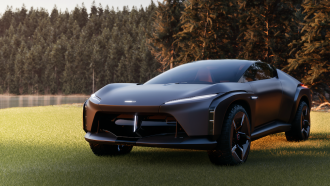Journeying the world is already a hard feat, not to mention the North and South Pole which presents explorers with a challenging experience, something that Pole to Pole Electric Vehicle Expedition recently completed. The expedition has massive goals, with the trip itself being ambitious, particularly as it covered around 17,000 miles from their start to endpoints, using the Nissan Ariya EV as their workhorse.
Pole to Pole EV's focus is to tackle the Climate Crisis, as well as the electrification of the Polar exploration to avoid the need for gas-powered ones even in tough conditions.
Pole to Pole EV Expedition Completes North to South Pole Journey
(Photo : Pole to Pole EV via Instagram)
Pole to Pole EV's recent post on Instagram announced to the world that it already completed its grueling journey which began at the North Pole and ended at the South Pole. Husband and wife Chris and Julie Ramsey claimed that this is the first exploration using an electric vehicle that journeyed to both poles on land, showing off the capabilities of their chosen EV for the trip.
Their electric car of choice is the Nissan Ariya e-4ORCE, an all-wheel drive, dual motor vehicle that only has a 272-mile range on its single charge. It was regarded that it only gave them around 150 to 200 miles of range given the load they brought, its mods, and the challenging cold conditions of both poles.
According to Electrek, the car saw modifications from an Iceland-based specialist, Arctic Trucks, equipping it with 39-inch tires for snow, as well as ice gears and body reinforcements.
Read Also: Science Weekly Roundup: IBM's Quantum Leap, Mysterious Dolphin with 'Thumbs'
Electric Vehicles for Pole Exploration and MORE
The all-electric Pole to Pole Expedition is not a race. It is a mindful, epic journey of discovery, learning and hope - meeting and sharing the stories of inspiring individuals and organizations who are doing amazing things in their communities to help tackle the Climate Crisis.
Pole to Pole EV Expedition's goal is to expand electric charging infrastructure in the Americas, as well as the environment, with their car centering on zero emissions and lessening its carbon footprint.
EVs and its Capabilities
One of the main concerns regarding electric vehicles is their capabilities to tackle different kinds of situations, terrains, and more, with many claiming that it has limitations because of its battery and drivetrain. However, on various occasions, companies have proven that EVs are just as capable as internal combustion engines (ICEs), with companies like Rivian, Ford, and more.
Additionally, manufacturers have added significant technology to the EVs released now, with some of the most advanced in the market, including the famed "crab walk" that brings locomotive improvements in the car's movement.
Charging is also not a problem now, as many companies and organizations have taken it upon themselves to deliver expansion for EVs, including the famed adoption of the Tesla NACS, with the addition of more Superchargers.
While there are still many limitations for EVs including range, interconnectivity, and charging stations in far-flung areas, many are providing the answer to those disputes for its wider adoption. This is what the Pole to Pole EV Expedition aims to address, especially with the Nissan Ariya which only features an original 272 miles of range, pushing the boundaries of the vehicle for awareness and the environment, from the North to South.
Related Article: Tesla Roadster: Is the Sports EV Coming? Here's What to Expect








